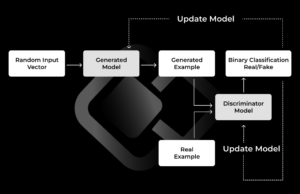Generative AI is innovative, capable of crafting diverse content across audio, code, images, text, simulations, and videos, sparking a revolution in multiple industries. These years have marked a series of remarkable breakthroughs in this field, pushing the boundaries of what was once deemed achievable. However, beyond its technological marvel, applications of generative AI transcend into a pragmatic tool with vast applications.
Therefore this blog aims to unravel the manifold ways in which generative AI influences and enhances business landscapes. From generating innovative product designs to optimizing intricate business processes and even conjuring entire virtual realms, the impact of generative AI is profound and expansive.
What is Generative AI?
Generative AI, short for generative artificial intelligence, represents a shift in artificial intelligence. Hence, it’s not merely a tool; it’s a creative force that breathes life into various forms of content—be it text, images, music, audio, or videos.
At the heart of generative AI’s prowess are foundation models—powerful, large-scale AI models that can multitask and perform many out-of-the-box tasks. Moreover, these tasks span diverse functions, including summarization, Q&A, classification, and beyond.
Their adaptability sets these models apart; with minimal training, they can be tailored for specific use cases, requiring only a scant amount of example data.
The Inner Workings of Generative AI

But how does generative AI achieve such creative feats? At its core, generative AI relies on machine learning models to discern patterns and relationships within a dataset composed of human-created content which involves training AI models. Once armed with this knowledge, the model takes on the role of a virtual creator, using the acquired patterns to craft entirely new content.
As we unravel the inner workings of generative AI models, we must delve into the diverse generative AI techniques that power their creative capabilities. These techniques, including GANs and VAEs, play a pivotal role in shaping how these models generate content across text, images, and more.
Undoubtedly understanding these generative AI techniques provides valuable insights into the creative processes that drive innovation in artificial intelligence.
Training generative AI commonly employs supervised learning, providing the model with a curated set of human-generated content and corresponding labels. The model learns to replicate the given content through this process and generate new content aligned with the same labels.
Applications of Generative AI in Business
Generative AI, with its ability to create diverse content, is not merely a technological marvel but a transformative force reshaping businesses across various sectors.
Image Generation and Manipulation
Generative AI’s prowess shines prominently in the realm of image generation. Offering text-to-image conversion, this application allows users to articulate their vision through textual prompts, prompting the AI to generate precise and realistic images.
The versatility extends to image enhancement and manipulation, enabling users to modify existing images with functions such as semantic image-to-image translation, image completion, image super-resolution, and overall image manipulation.
The impact on industries such as design, advertising, and content creation is profound, allowing for the creation of visually stunning and tailored content with minimal effort.
Software and Coding

In the domain of software development and coding, generative AI is revolutionizing traditional practices. Code generation stands out as a prominent application, where AI models trained on extensive code repositories automate the generation of code functions, snippets, or entire programs based on specific requirements.
In addition to that, this accelerates software development by automating repetitive coding tasks and allows developers to focus on higher-level design and problem-solving.
Code completion further enhances coding efficiency, offering intelligent suggestions based on context, while natural language interfaces for coding bridge the gap between domain experts and developers, streamlining collaboration and resource utilization.
Video Creation
Generative AI applications extend their influence to video creation, simplifying and enhancing the video production process. These applications automate tasks such as video composition, animation, special effects addition, and video snippet editing. Additionally, generative AI excels in video style transfers and predictions, bringing innovation to the filmmaking and content creation industries.
Moreover, generative AI proves invaluable in 3D shape generation, contributing to creating highly detailed and intricate shapes that might be challenging to achieve manually.
Audio Generation
Audio generation emerges as another frontier for generative AI, offering solutions in text-to-speech (TTS) generation, music creation, and speech-to-speech (STS) conversions. TTS generators create realistic speech audio from textual prompts, proving useful in applications like speech-based interfaces and assistive technologies. Music creation through generative AI unlocks new possibilities, generating diverse music pieces based on learned styles and patterns.
STS conversions find applications in gaming and filmmaking, henceforth allowing professionals to seamlessly create voiceovers and enhance the auditory elements of their projects.
Text Generation and Summarization
Generative AI’s impact on content creation is evident in text generation and summarization applications. Tools like ChatGPT exemplify the ability to create and summarize textual content based on user prompts. In addition to content creation, generative AI facilitates language translation, virtual assistants, chatbots, content aggregation, and automated report generation.
From crafting engaging blogs and social media copies to aiding language translation tasks, generative AI is a versatile tool for businesses seeking efficiency in communication and content management.
As businesses explore the versatile applications of generative AI, one area that prominently stands out is Natural Language Processing (NLP). In the realm of Text Generation and Summarization, generative AI models, such as ChatGPT, exemplify their ability to create and summarize textual AI generated content based on user prompts.
Organizational Collaboration: Elevating Team Dynamics
The latest advancements in generative AI systems contribute to enhanced organizational collaboration. Automation augments personal productivity tools like word processing and email, boosting accuracy and efficiency.
Real-world implementations, such as Microsoft’s integration of GPT-3.5 in Teams Premium, showcase how AI systems can streamline meeting recordings, providing better reference and organization.
Jasper.ai, a startup leveraging generative AI, further exemplifies the potential for automation in tedious writing tasks, enabling businesses to achieve more with fewer resources.
Chatbot Performance Improvement
Generative AI enhances chatbot performance, fostering more engaging and effective interactions. Through natural language understanding (NLU) enhancement, generative AI models analyze vast amounts of text data, enabling chatbots to understand user inputs better, extract intent, and determine entities.
The ability to generate human-like responses and handle open-ended prompts adds a layer of sophistication to chatbots, making them more adaptable and responsive in diverse conversational scenarios.
Enterprise Search: Streamlining Information Retrieval
Generative AI emerges as a valuable tool for efficient information retrieval. Therefore organizations can leverage generative AI models to sift through vast amounts of documentation, including contracts, research reports, and business trend analyses.
This expedites the search process and automatically highlights crucial sections, facilitating quick access to pertinent information.
Generative AI Use Cases Across Industries: A Paradigm Shift in Innovation
As we delve into the diverse applications of generative AI, it’s imperative to explore its role in generating synthetic data analysis.
This application extends beyond traditional boundaries, offering novel solutions and optimizing data-driven decision-making processes.
Logistics and Transportation:
- Application of Generative AI: Accurate conversion of satellite images into detailed map views.
- Impact: Facilitates navigation in unfamiliar territories, aiding logistics and transportation companies in efficient route planning
Travel Industry:
- Application of Generative AI: Facial recognition and verification systems at airports.
- Impact: Simplifies passenger identification by creating comprehensive images from various angles, enhancing security measures.
Retail:
- Application of Generative AI: Enhancing customer experience through personalized messaging.
- Impact: Delivers tailored messages to consumers, analyzing communications for signs of fraudulent activities like phishing attempts.
Supply Chain:
- Application of Generative AI: Prediction of demand for specific products to optimize supply chain operations.
- Impact: Reduces inventory costs, improves order fulfillment times, and minimizes waste and overstocking.
Energy Sector:
- Application of Generative AI: Predicting solar and wind output based on weather data.
- Impact: Optimizes grid integration, handles resource variability, and predicts energy market prices for optimized trading strategies.
Marketing:
- Application of Generative AI: Customer segmentation and prediction of target group responses.
- Impact: Enables businesses to target specific audiences, enhancing the effectiveness of advertising and marketing campaigns.
These applications showcase the versatility of generative AI in addressing industry-specific challenges and fostering innovation. Evidently, as industries continue to embrace this technology, the potential for creative solutions and operational enhancements becomes increasingly evident.
How?
The applications of generative AI underscore its role as a catalyst for innovation across diverse industries. So let’s delve deeper into how generative AI is making significant strides in transforming sectors:
- Applications of Generative AI: The impact of generative AI is profound, from facial recognition in the travel industry to personalized messaging in retail. This technology is at the forefront of revolutionizing traditional logistics, supply chain, energy, and marketing practices.
- Generative AI Models: The success of these applications hinges on sophisticated generative AI models. Technologies such as Generative Adversarial Networks and Variational Autoencoders (VAEs) play pivotal roles in generating content, optimizing supply chains, and predicting outcomes.
- Generative AI Tools: Implementing generative AI tools is crucial for seamless integration into existing systems. Therefore, these tools facilitate the creation of comprehensive images, predict demand, and enhance customer experiences through personalized interactions.
- Implementing Generative AI: Successful integration requires a strategic approach to implementing generative AI. Understanding historical data, training models with diverse datasets, and ensuring ethical and legal considerations are paramount for effective deployment.
- Leveraging Generative AI for Competitive Advantage: Industries can leverage generative AI to gain a significant competitive advantage. The benefits are extensive, from optimizing energy distribution to enhancing customer satisfaction through personalized interactions.
- Generative AI in Software Development: The use of generative AI extends to software development, where code generation and natural language interfaces streamline coding processes. This not only accelerates development but also enhances the overall quality of code.
Risks of Generative AI

As the realm of generative AI expands and its applications proliferate across industries, it is crucial to recognize and address the inherent risks associated with this transformative technology. While the potential benefits are vast, an informed approach is essential to mitigate the evolving challenges.
Gartner laid down some of the potential risks with the Generative AI:
Lack of Transparency: Unpredictable AI Models
Generative AI models, including ChatGPT, are intricate systems with inherent unpredictability. The lack of complete transparency poses a risk, as even the developers may not fully comprehend every aspect of how these models generate responses.
Organizations must grapple with the uncertainty and adopt strategies to manage the potential impact on decision-making and information reliability.
Accuracy Concerns
In their quest to create content, generative AI systems may produce inaccuracies and fabricated information. Businesses should exercise caution and rigorously assess all outputs for accuracy, appropriateness, and genuine usefulness before relying on or publicly disseminating the generated information.
A thorough validation process becomes imperative to maintain the integrity of the information generated.
Bias in Outputs
Generative AI is susceptible to biases present in the training data. Organizations need robust policies and controls to detect biased outputs and handle them in alignment with company policies and relevant legal requirements.
This is essential to ensure fair and unbiased results, preventing unintentional reinforcement of existing prejudices or discriminatory practices.
Intellectual Property and Copyright Challenges
Generative AI tools like ChatGPT operate without verifiable data governance and protection assurances. This raises concerns about the exposure of confidential enterprise information.
Users should assume that synthetic data entered into generative AI platforms may become public, necessitating stringent controls to avoid inadvertent exposure of intellectual property (IP).
Companies must develop strategies to protect sensitive information and adhere to copyright laws.
Cybersecurity and Fraud Risks

Enterprises must be vigilant against malicious actors exploiting generative AI systems for cyber and fraud attacks. The technology’s ability to create realistic deep fakes raises concerns, particularly in social engineering of personnel. Organizations should implement robust controls to mitigate these risks and collaborate with cyber insurance providers to verify coverage for AI-related breaches.
Sustainability Challenges
Generative AI’s significant electricity consumption poses sustainability challenges. Organizations should prioritize vendors that are committed to reducing power consumption and leveraging renewable energy sources.
This ensures a conscientious approach to technology adoption, aligning with sustainability goals and minimizing the environmental impact.
Key Considerations and Questions for Responsible Use
Beyond these identified risks, organizations must grapple with critical questions to ensure the responsible use of generative AI:
- Defining Responsible Use: Who defines responsible use of generative Artificial Intelligence, especially as cultural norms evolve and social engineering approaches vary across geographies? Who ensures compliance, and what are the consequences for irresponsible use?
- User Consent: In the event of issues, how can individuals take action? How do users give and remove consent (opt-in or opt-out)? What lessons can be learned from ongoing privacy debates?
- Trust in Organizations: Will using generative artificial intelligence apps help or hurt trust in your organization and institutions overall? How can organizations ensure that content creators retain control of their IP and receive fair compensation?
- Regulatory Landscape: Given the evolving regulatory landscape, how can organizations ensure proper functioning throughout the entire life cycle of generative AI technology? Do boards need an AI ethics lead to navigate these complex ethical considerations?
How to Build a Generative AI Model
Building a generative AI model is a nuanced process that spans from data collection to model deployment. The journey involves several critical steps, each demanding meticulous attention to detail. Let’s delve into a high-level overview of the process to demystify the intricacies of constructing a generative AI model.
1. Data Collection: Laying the Foundation
The foundation of any generative AI model is laid with an extensive and diverse dataset in the domain of interest. Whether it’s images, sentences, sounds, or other types of data, the quality and diversity of the dataset profoundly influence the model’s performance.
2. Preprocessing: Refining for Training
Collected data undergoes preprocessing to make it conducive for training the model. This step may involve resizing images, tokenizing text, or normalizing audio signals, ensuring that the data is appropriately formatted and filtered for optimal model performance.
3. Model Selection: Choosing the Right Architecture
Selecting an apt generative model is pivotal. Depending on the application, this could involve choosing a Generative Adversarial Network (GAN), a Variational Autoencoder (VAE), or an autoregressive model like PixelRNN. The choice is dictated by the nature of the data and the desired outcomes.
4. Model Training: Iterative Learning Process
With the model selected, the training process begins. This iterative learning involves adjusting the model’s parameters to generate data closely resembling the collected dataset. The computational resources required for this step are often substantial, emphasizing the need for robust hardware.
5. Model Evaluation: Ensuring Fidelity
Post-training, the model undergoes evaluation to ensure it generates data that faithfully represents the original dataset. Visual inspection, in the case of image data, or more quantitative measures for other data types, helps gauge the model’s fidelity.
6. Model Deployment: Bridging Theory and Application
Once the model has been satisfactorily trained and evaluated, it is ready for deployment. This could entail integrating the model into an existing system or building new applications that leverage the generative capabilities.
Key Considerations Throughout the Process:
- Data Quality and Diversity: The success of a generative AI model hinges on the richness and diversity of the dataset. Ensure a robust data collection strategy to enhance model performance.
- Model Flexibility: Choose a generative model that aligns with the application’s specific requirements. Different models excel in different domains, so understanding the strengths of each is crucial.
- Computational Resources: Model training demands significant computational resources. Be prepared to allocate the necessary hardware for efficient and timely training.
- Continuous Iteration: Building a generative AI model is not a one-time task. Continuous iteration and refinement are essential to adapt to evolving data patterns and enhance the model’s capabilities.
- Ethical Considerations: Throughout the process, be mindful of ethical considerations, including bias in data and outputs, to ensure responsible and fair AI applications.
Have an Artificial intelligence App idea? TechAhead is there for you.
In a world driven by mobile experiences, integrating AI in mobile apps has become a game-changer, especially for tech startups. TechAhead, with its extensive experience in AI development, empowers startups to conquer their market by leveraging the following key aspects:
- Customer-Centric Intelligent Applications: We specialize in developing AI-powered mobile apps that go beyond mere functionality. Our apps understand user behaviour, preferences, and needs, providing a personalized and engaging experience.
- Operational Efficiency: TechAhead’s AI solutions streamline operational processes, saving costs and increasing efficiency. Whether it’s automating manual tasks or enhancing decision-making processes, our AI-powered apps are designed to maximize productivity.
- Cybersecurity Integration: Security is paramount in the digital age. TechAhead incorporates AI-driven cybersecurity measures to guard against potential threats, ensuring user data remains secure and confidential.
- Enhanced Customer Relationship Management (CRM): Our AI-powered CRM systems can self-update and auto-correct data, ensuring businesses maintain closer customer connections. From triggered promotional offers to intelligent customer interactions, we redefine CRM through AI.
Why Choose TechAhead?
- Global Recognition: TechAhead is globally recognized, and consistently chosen by renowned brands for its commitment to excellence.
- Technological Expertise: As a Microsoft Certified Gold Partner, Google’s Development Agency partner, and AWS Certified Engineers, we bring unparalleled technological expertise to the table.
- Transparent Pricing Models: Our pricing models are transparent, ensuring that you get the best value for your investment.
- Dedicated Support: TechAhead’s dedicated team is always at your service, providing valued consultancy before, during, and after the development process.
Conclusion
Generative AI is a revolutionary force reshaping industries from image and software development to video creation and beyond. Its creative power, driven by advanced models, unlocks opportunities for streamlined processes and enhanced collaboration.
While businesses embrace this transformative technology, a responsible and ethical approach is crucial. Synergy of next generation AI with human ingenuity promises a future where innovation knows no bounds, marking a new era of creativity, efficiency, and progress in the business landscape.
Contact TechAhead today for all your web and mobile app development needs.








